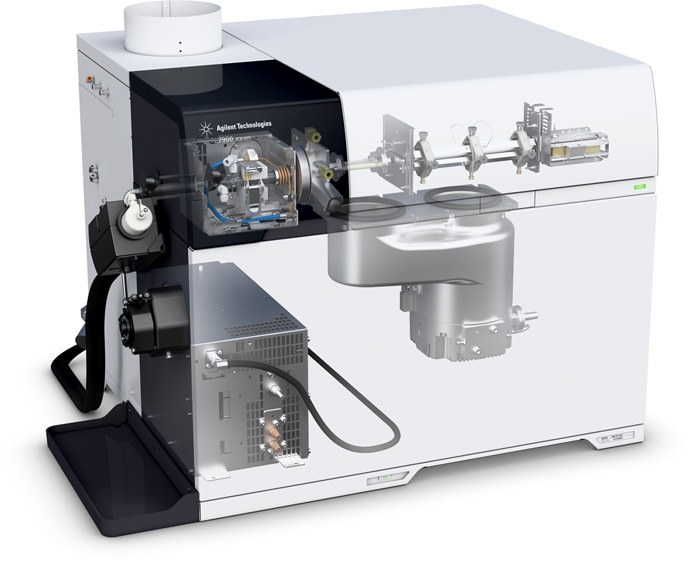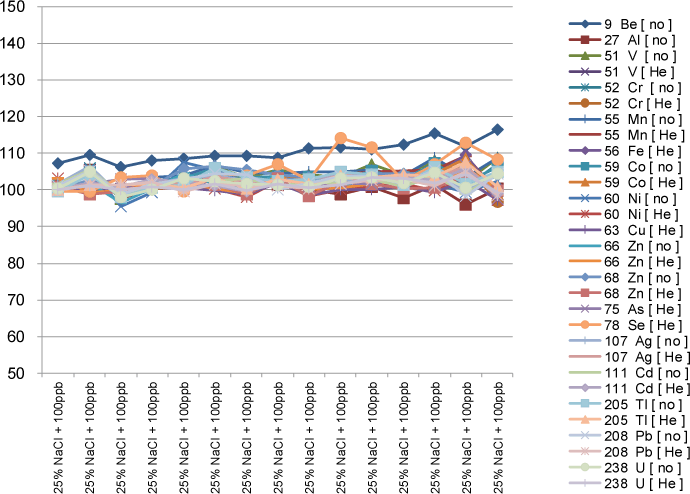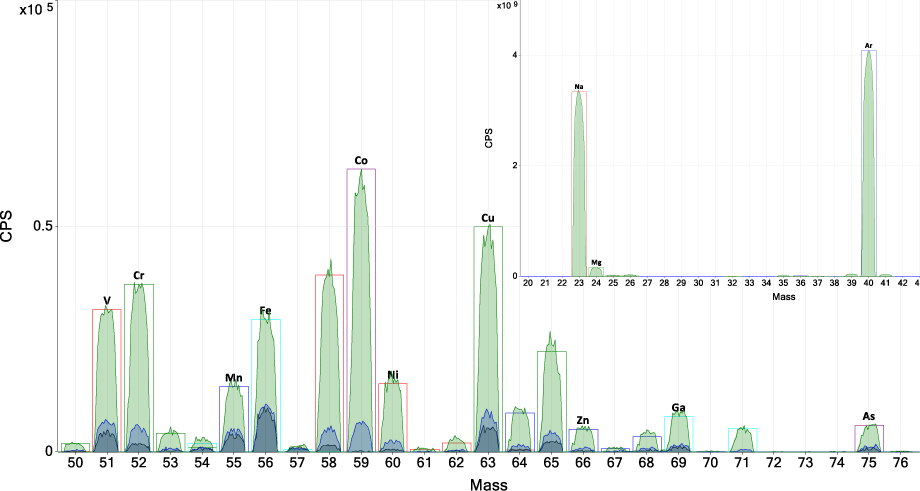Access Agilent eNewsletter, February 2014
>> Update My Profile | Subscribe to Access Agilent | Article Directory
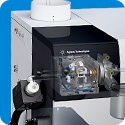
Redefining elemental analysis:
Agilent’s new 7900 extends the range of ICP-MS
to higher analyte concentrations and matrix levels
By Ed McCurdy
Agilent ICP-MS Product Marketing
and Tomoyuki Yamada
Agilent ICP-MS Product Manager
Quadrupole Inductively Coupled Plasma Mass Spectrometry (ICP-MS) is the technique of choice for low-level elemental analysis across a wide range of industries and research applications. ICP-MS offers a combination of low detection limits, wide elemental coverage, and fast multi-element analysis. Recent developments in collision/reaction cell technology have also improved the control of interferences, ensuring that most elements can be measured reliably even in complex and variable matrices.
Historically however, ICP-MS has been thought suitable only for trace-level analysis and has been considered unable to tolerate samples that contain high levels of total dissolved solids (TDS). There are valid reasons for these limitations:
- In many industries, trace analytes must be quantified at extremely low levels; single or sub ng/L (ppt) level quantification is commonly required in food, environmental, and clinical applications, as well as high purity chemical and semiconductor fields. In order to measure elements at such low levels, an ICP-MS must have very high sensitivity, with the result that major elements may produce a signal that is over the range of the detector. ICP-MS has one of the widest linear dynamic ranges of any analytical technique at about 9 orders of magnitude, but for an element with a detection limit of 0.1 ng/L, the upper measurement limit (9 orders higher) would be just 100 mg/L (ppm). This limitation has meant ICP-MS is not typically used for major element measurement in most sample types, which often leads to laboratories having to run each sample twice – once by ICP-MS for trace analytes and a second time using a different technique (usually ICP-OES or flame AAS) for major elements.
- Direct mass spectrometric measurement requires that ions are sampled from the ICP and passed through an interface to the high vacuum region where the mass spectrometer is located. The interface uses small diameter orifices in order to maintain the vacuum, and these orifices are susceptible to clogging by high levels of sample matrix. This limitation has led to adoption of a typical matrix limit of 0.2% (2000 ppm) TDS for samples to be measured by ICP-MS. Many natural aqueous samples, such as urine and highly saline waters, as well as digested solid materials, will far exceed this TDS limit, so such samples are typically diluted prior to analysis by ICP-MS. However, sample dilution introduces both workflow and analytical compromises, including degradation of detection limits for trace elements, potential for sample contamination, added cost of reagents and time to perform the dilutions, and additional waste disposal costs.
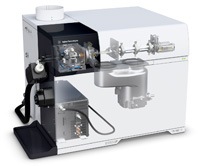 Enlarge
Enlarge
Figure 1. New Agilent 7900 ICP-MS.
New technology overcomes long-standing limitations of ICP-MS
The new Agilent 7900 quadrupole ICP-MS (Figure 1) has been developed to address these limitations of ICP-MS, introducing a range of new technologies that extend the range of the technique to higher matrix levels and higher analyte concentrations, while also enhancing ease-of-use and productivity.
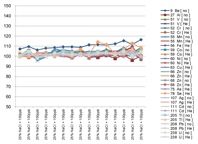 Enlarge
Enlarge
Figure 2. Recovery of 100 ug/L spike in 25% NaCl matrix; stability over 4 hours.
UHMI technology provides unprecedented matrix tolerance
Agilent’s unique, patented High Matrix introduction (HMI) technology has been field proven in the earlier 7500 and 7700 Series ICP-MS and Agilent 8800 ICP-QQQ instruments, providing the ability to run matrix levels of up to 2% TDS, a factor of 10 higher than conventional ICP-MS systems. A new Ultra High Matrix Introduction (UHMI) system has been developed for the Agilent 7900, which extends the aerosol dilution range by a further factor of 10, allowing TDS levels of up to 25% to be run, a level that is even beyond the capability of some ICP-OES systems. This level of matrix tolerance is unprecedented in ICP-MS, allowing samples such as saturated brine (25% NaCl) to be run routinely, without prior dilution (see Figure 2). UHMI has a further benefit that a high carrier gas flow rate is maintained, even when the aerosol dilution factor is high, so the aerosol is flushed from the spray chamber more quickly between samples.
Wider concentration range delivers simplified routine analysis
It would be easy to increase the upper measurement limit of ICP-MS simply by attenuating the ion transmission or reducing detector gain. This however, would only move the measurement range upwards, rather than extending it, so detection of low concentration analytes would be compromised. The new Agilent 7900 ICP-MS has a combination of a new interface vacuum design, ion lens and detector system providing lower random background, higher ion transmission, and an extended analog mode measurement range. These developments provide a factor of 10 higher signal to noise (S/N) for better detection limits, coupled with a 10x higher upper measurement limit, so major elements at levels of 1000 ppm or more can now be quantified in the same run as the trace elements.
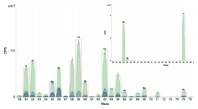 Enlarge
Enlarge
Figure 3. Overlaid spectra of undiluted CASS-4 seawater reference material, measured unspiked and with spikes of 1 ug/L and 10 ug/L (ppb) using He mode on the Agilent 7900. Inset image shows the major Na peak measured at approximately 1% (9,500 mg/L (ppm).
This extended measurement range is illustrated in the inset spectrum in Figure 3, which shows the Na peak measured in an undiluted seawater sample. Coastal seawater has a salinity of about 3% (30 g/L salt), of which approximately one third (1%) is Na. The ability to measure Na in seawater therefore demonstrates that the Agilent 7900 ICP-MS is able to quantify major elements at far above the TDS limit of most ICP-MS systems. While measurement of undiluted seawater does require UHMI, the aerosol dilution factor used reduces overall sensitivity by only about a factor of 10, so trace elements can still be quantified at ng/L levels in the same run (main spectrum). The extended dynamic range of Agilent’s 7900 has the potential to simplify routine analysis of many sample types, as a second analytical measurement for major elements may no longer be necessary.
Redesigned ISIS contributes to increased productivity and ease-of-use
Agilent’s third generation Integrated Sample Introduction System (ISIS 3) has been redesigned for the 7900 ICP-MS, with a new close-coupled, 7-port switching valve situated next to the nebulizer. This ensures that sample tubing lengths are minimized, so reducing both the delay times for stabilization and the surface area of the uptake tubing that the sample passes through. In addition, the Agilent 7900 includes a fourth generation collision/reaction cell, the ORS4. The new cell uses a novel gas controller design which reduces stabilization times to less than 3 seconds when switching between cell gases. Together, these new developments contribute to increased productivity, which is particularly important in busy commercial laboratories. An EPA Method 6020 compliant multi-mode analysis (2 cell modes, so all elements are measured under optimum conditions) can now be completed in less than 60 seconds – sample to sample time.
ICP-MS MassHunter 4.1: the simplest, most powerful, and most flexible software for ICP-MS
 Enlarge
Enlarge
Figure 4. ICP-MS MassHunter 4.1 tool bar.
To complement this phenomenal new hardware performance, Agilent has completely reworked the ICP-MS MassHunter software, based on careful study of customer workflows across multiple industries, coupled with suggestions and requests from our customers and application specialists. The result is ICP-MS MassHunter 4.1, which uses a highly intuitive, simple user interface with software “Gadgets” to guide the user through the processes of hardware configuration, instrument optimization, sample acquisition, and data analysis (Figure 4). New users will appreciate simple startup, auto-optimization and guided operation while experienced researchers can still access unprecedented power and flexibility.
Agilent ICP-MS Journal
Are you interested in trace metals analysis and eager to keep up-to-date with the latest developments in the field of ICP-MS? Then we invite you to take a closer look at Agilent’s dedicated ICP-MS Journal. Published four times a year and available as a PDF, you can view the latest issue of the ICP-MS Journal, plus all previous copies, by visiting the ICP-MS Journal Archive.
To receive a personal copy of the ICP-MS Journal direct to your inbox, please sign up here.
>> Update My Profile | Subscribe to Access Agilent | Article Directory
